Lanzarote Neighborhoods, Locations, Towns and Villages
(Lanzarote, Canary Islands, Spain)
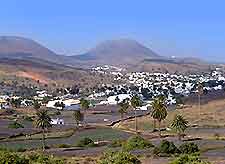
The most easterly of all the Canary Islands, Lanzarote is extremely popular and visited by tourists throughout the year, who travel to the island to enjoy the endless beaches, the spectacular volcanic scenery and the sunny weather. Lanzarote is made up of a series of towns, villages and districts, all of which have plenty to offer visitors.
Arrecife, the capital of Lanzarote, is a bustling town and contains some of the island's best shopping, while nearby, the Teguise and Costa Teguise areas of the island are home to a number of excellent beaches, such as the Playa de las Cucharas.
The island's northern side contains a number of charming villages, such as Arrieta, Guatiza, Malpais de la Corona and Tahiche, providing many interesting sightseeing opportunities. However, the southern side of Lanzarote is where all the action happens, being home to many of the best beach resorts, such as Puerto del Carmen and the Playa Blanca, both of which offer stunning stretches of sandy beaches and a range of water sports.
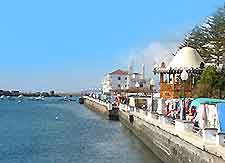
Arrecife
The capital of Lanzarote since 1852, Arrecife is a busy town close to the airport, with a population of around 45,000. Although not one of the island's most appealing towns, Arrecife still has much to offer and is home to a good selection of hotels and a natural harbour area, providing a range of scenic walking trails and popular boat trips. Regular ferry trips to and from Puerto del Rosario (on the nearby island of Fuerteventura) are available from here. One of the main landmarks in Arrecife is without doubt the Castillo de San José, which dates back to the late 18th century and contains the popular Museum of Contemporary Art, now one of the island's premier art galleries, boasting works by Miró and Picasso, amongst others.
Most of the main attractions in Arrecife are concentrated around the town centre, with a range of shopping opportunities particularly clustered around the streets of Calle José Antonio, Canalejas and Fajardo. Many top shops and restaurants also line the Calle León y Castillo and the main promenade. Notable festivals in Arrecife include the Carnaval each February / March - with further celebrations around Lanzarote, and the Dia de San Ginés - which is celebrated at the end of August at the historic Iglesia de San Ginés. Also, the nearby San Bartolomé area is known for its striking Monument to the Farmer (Monumento al Campesino), which was erected in 1968 by César Manrique, with a related museum nearby.
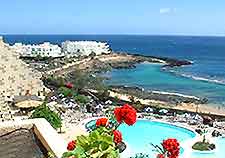
Costa Teguise and Teguise
Just a few miles to the north-east of Arrecife, Teguise is an important port town and was the capital of Lanzarote until 1852. Over the years, much of the island's wealth has been generated by the busy port in Teguise, although today, tourism is the biggest industry. Teguise is a historic spot containing a number of well-preserved buildings, such as the Palacio Spinola, which can be found on the Plaza de Constitución and is the official home of the Government of the Canary Islands, together with a small museum containing many local artefacts.
Other places of interest in the Teguise area of Lanzarote include the Iglesia de la Virgen de Guadalupe, which has origins in the 16th century, with several nearby monasteries, such as both the Convento de Santo Domingo and the Convento de Miraflores. Teguise is also home to the Castillo de Santa Bárbara, the oldest fortress on both Lanzarote and the whole of the Canary Islands, located high up on the Guanapay Peak and offering impressive views, containing the small Museo del Emigrante Canario.
Nearby, the Costa Teguise is a popular resort, with many low-rise hotels and sandy beaches with good facilities, including the Playa de las Cucharas beach, stretching for over 600 metres / 1,968 feet and featuring clear waters suitable for swimming and windsurfing. Much of the Costa Teguise is centred around the Las Cucharas Commercial Centre, one of Lanzarote's biggest shopping centres offering a plethora of shops and local businesses. The Costa Teguise also features a selection of local markets, including one held in the Pueblo Marinero.
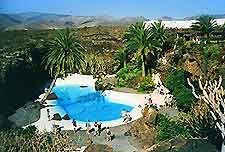
Northern Towns
The northernmost towns and villages on Lanzarote contain a diverse mixture of both natural and man-made attractions, with the main highlights being based around Arrieta, Guatiza, Malpais de la Corona, Tahiche and the Minor Canaries. Just above Arrecife, Tahiche stands at the bottom of Lanzarote's northern region and contains the island's famous César Manrique Foundation, which celebrates the life of this famous local Canarian artist and contains many of his works, together with pieces by other noteworthy artists, such as Miró and Picasso.
To the north of Tahiche, the small village of Guatiza is best known for its proximity to the Jardin de los Cactus, one of the most unusual and stunning gardens on the whole of Lanzarote. Created in 1989 by Caesar Manrique, the garden contains over 10,000 cactus specimens, with each one being clearly labelled.
Further north, Arrieta is a small and yet notable fishing village, with a clear and relatively quiet sandy beach - the Playa de la Garita. A number of small hotels and guest houses can be found in this part of Lanzarote and offer a peaceful spot away from more commercial tourist resorts. Arrieta also features a scenic jetty area, complete with a restaurant providing fine dining and coastal views.
The nearby Malpais de La Corona area is a particularly volcanic part of Lanzarote and contains two of the island's most stunning natural features, the Los Jameos del Agua and the Cueva de los Verdes caves. Both located near to each other, these spectacular caverns consist of a network of underground tunnels, caves and lakes, being created by molten lava and gas bubbles around 3,000 years ago.
At the northern tip of Lanzarote, a small group of islands are known locally as the Minor Canaries and are all fairly insignificant, with the exception of the Isla Graciosa, which has become an important nature reserve in its own right. Many people visit the Isla Graciosa, also known as La Graciosa, to enjoy both the native flora and fauna, together with the excellent surfing conditions and coastline.
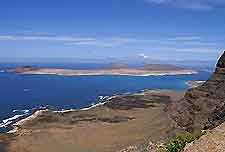
Northwestern Towns
The north-western side of Lanzarote contains many of the island's best sightseeing opportunities and most rewarding attractions, where numerous attractive towns can be found. The Mirador Del Rio is one of the most famous spots here and is an eye-catching building situated in front of the Famara Cliffs. Designed by César Manrique, the Mirador Del Rio offers breathtaking views of the El Rio and the distant Isla Graciosa, with a dramatic 500-meter / 1,640-foot drop nearby.
Just 5 km / 3 miles to the south of the Mirador Del Rio, the village of Guinate contains the popular Guinate Tropical Park, which regularly attracts tourists from all over Lanzarote. With more than 1,000 colourful and exotic birds, together with entertaining parrot shows, landscaped gardens, lakes and a restaurants, this theme park is the main reason people visit Guinate.
Nearby, the enchanting seaside hamlet of Famara remains firmly rooted in the past. The La Caleta de Famara is a fairly rugged beach and offers some of Lanzarote's best waves, which are famed throughout Europe and visited by many experienced surfers. A number of surf shacks are located nearby, hiring out a range of equipment.
Inland and Western Coast
Both inland and western areas of Lanzarote are within easy reach of the southern resorts and offer an altogether less-developed area of the island. Le Geria is located close to San Bartolomé and contains an unusual selection of wineries, with established vineyards thriving in the dark, volcanic soils of the region. Often fairly small in size, the vineyards in this part of Lanzarote become more concentrated as you travel south.
To the south-west of Le Geria, Yaiza is a well-presented town, with little to offer apart from a few excellent restaurants serving local cuisine and some well-placed hotels. The local 18th-century church, the Iglesia de Nuestra Senora de los Remedios, adds a historic character to the town, featuring imposing architecture and an elaborate altarpiece.
On the south-western coast of Lanzarote, El Golfo is a quiet fishing village and the perfect contrast to more mainstream beach resorts nearby. With a number of small, black sandy beaches, El Golf is best known for its imposing natural rock amphitheatre, which contains a 'green lagoon' lake and is now a protected nature reserve. Several good restaurants are located nearby, together with a small hotel.
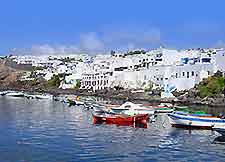
Southern Towns
The southern side of Lanzarote contains many of the island's top beach resorts and tourist hotspots, attracting families, sun lovers and those looking for holiday entertainment. The Puerto del Carmen is the island's most popular beach area and top resort, with around 6 km / 4 miles of golden sand and plenty of recreational activities. Running alongside the beach, the Avenida Playas is the Puerto del Carmen's main artery and is lined with shops, restaurants, hotels and nightclubs. Apart from sunbathing, other beach attractions here include windsurfing, jet skiing, banana boats, fishing and scuba diving.
Lanzarote's Playa Blanca is located nearby and is just a short distance from the sands of Corralejo on the neighbouring island of Fuerteventura. Fairly secluded and quiet, the main beaches around the Playa Blanca can be found of the eastern side, at Punta del Papagayo. Regular boat trips are available from this part of Lanzarote and travel to the small island named the Isla de Lobos, which is located at the northern tip of Fuerteventura
Sited slightly to the west of Puerto del Carmen and close to Playa Blanca, Puerto Calero is a quiet yacht harbour, with several local eateries serving up traditional Lanzarote cuisine, together with a range of speciality shops. Attractions here include deep-sea fishing trips, underwater safaris onboard a yellow submarine, and scenic harbour cruises.
 The most easterly of all the Canary Islands, Lanzarote is extremely popular and visited by tourists throughout the year, who travel to the island to enjoy the endless beaches, the spectacular volcanic scenery and the sunny weather. Lanzarote is made up of a series of towns, villages and districts, all of which have plenty to offer visitors.
The most easterly of all the Canary Islands, Lanzarote is extremely popular and visited by tourists throughout the year, who travel to the island to enjoy the endless beaches, the spectacular volcanic scenery and the sunny weather. Lanzarote is made up of a series of towns, villages and districts, all of which have plenty to offer visitors.



